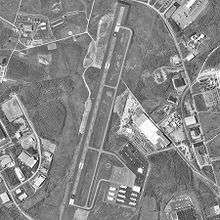John C. Tune Airport
John C. Tune Airport (ICAO: KJWN, FAA LID: JWN) is a public airport located in the western portion of the city of Nashville in Davidson County, Tennessee, United States. It is owned by the Metropolitan Nashville Airport Authority,[1] located approximately one mile (1.6 km) off of Briley Parkway in the Cockrill Bend area. It is a Class E airport.
John C. Tune Airport | |||||||||||
|---|---|---|---|---|---|---|---|---|---|---|---|
 USGS aerial image, 2008 | |||||||||||
| Summary | |||||||||||
| Airport type | Public | ||||||||||
| Owner | Metropolitan Nashville Airport Authority | ||||||||||
| Serves | Nashville, Tennessee | ||||||||||
| Elevation AMSL | 495 ft / 151 m | ||||||||||
| Coordinates | 36°10′56″N 086°53′12″W | ||||||||||
| Map | |||||||||||
 JWN Location of airport in Tennessee / United States  JWN JWN (the United States) | |||||||||||
| Runways | |||||||||||
| |||||||||||
| Statistics (2009) | |||||||||||
| |||||||||||
Although most U.S. airports use the same three-letter location identifier for the FAA and IATA, this airport is assigned JWN by the FAA but has no designation from the IATA.[2]
History
Tune Airport is named in honor of John Childress Tune, a Nashville attorney, civic leader, longtime aviation enthusiast and one of the principal developers of the modern aviation authority concept. He was also a former chairman of the Metropolitan Nashville Airport Authority. Planning for the construction of Tune Airport began in 1965 under Nashville's former Department of Aviation as a "reliever airport" designed to provide additional capacity at Nashville International Airport (Berry Field). The Department of Aviation received a state grant to purchase the Cockrill Bend property, and construction for the airport began in 1983. John C. Tune opened in July 1986. The current terminal was built in 1995 and renovated in 2015.
On March 3, 2020, the airport suffered significant tornado damage to its terminal and other buildings, including 17 hangars on the property; more than 90 aircraft parked at the airport—including charter jets, smaller airplanes, and a newsgathering helicopter operated by CBS affiliate WTVF (channel 5)—were destroyed.[3]
Facilities and aircraft
John C. Tune Airport covers an area of 390 acres (160 ha) at an elevation of 495 feet (151 m) above mean sea level. It has one asphalt paved runway designated 2/20 which measures 6,001 by 100 feet (1,829. x 30 m).[1] The runway is long enough to serve corporate jets such as Lear Jets. For the 12-month period ending March 6, 2009, the airport had 72,998 aircraft operations, an average of 199 per day: 70% general aviation, 29% air taxi and <1% military. At that time there were 165 aircraft based at this airport: 79% single-engine, 16% multi-engine, 3% jet and 2% helicopter.[1]
Corporate Flight Management provides Fixed-Base Operator services for the airport. JWN has 120 T-hangars, plus 21,000 square feet (2,000 m2) and 19,000 square feet (1,800 m2) box hangars that include offices. Aircraft parking and apron space totals 360,000 square feet (33,000 m2), which can accommodate 55 tie-down aircraft. The airport has a precision instrument landing approach into Runway 20. Both Runways 2 and 20 have non-precision instrument approaches.
JWN is financially self-supporting, although some improvements are made with the assistance of state and federal grant money.
Services
John C. Tune Airport provides:
- 24-hour personnel service
- Avgas
- Jet fuel
- Aircraft and helicopter maintenance
- Private and commercial pilot certification
- Lasergrade testing
- Instrument rating courses
- Flight instructor certification courses
- Flight simulator training
- Helicopter pilot training
- Lavatory disposal
Renovations
John C. Tune's terminal received a significant renovation that was completed in 2005. The 3,600-square-foot (330 m2) updated terminal includes a pilot's lounge, conference room, flight planning room, vending area and pilot supply shop. Additional landscaping and parking renovations were completed in 2009.
References
- FAA Airport Master Record for JWN (Form 5010 PDF), effective 2009-07-02.
- Great Circle Mapper: KJWN - John C. Tune Airport - Nashville, Tennessee
- Laken Bowles (March 4, 2020). "Tornado causes $93M worth of damage at John C. Tune Airport". WTVF. E. W. Scripps Company. Retrieved March 9, 2020.
External links
| Wikimedia Commons has media related to John C. Tune Airport. |
- John C. Tune Airport
- FAA Terminal Procedures for JWN, effective August 13, 2020
- Resources for this airport:
- FAA airport information for JWN
- AirNav airport information for JWN
- FlightAware airport information and live flight tracker
- SkyVector aeronautical chart for JWN